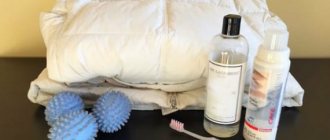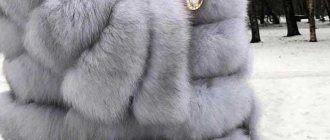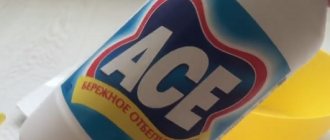Rules for selecting whitening products
In order not to damage the fiber structure, spoil the product or shorten its service life, we follow simple rules.
- We bleach the shirt no more often than after four washes, otherwise the fabric will become thinner;
- When using ready-made bleach, follow the recommendations from the instructions;
- When washing a bleached shirt, do not put other things in the drum, especially colored ones;
- We wash natural and synthetic products separately;
- if a white shirt has colored inserts, wash it with added salt;
- We don’t store white things folded, because this way they turn yellow faster.
Getting rid of rust and oil stains
It is quite possible to remove these specific marks from a white shirt:
- Citric acid effectively removes rust from flax. Add a spoonful of acid to 250 ml of boiling water and dip the stain into this solution. Then wipe with ammonia.
- Remember, if there is a rust stain on a shirt, you can wash it only after removing the rust. If this is not done, the blouse will turn yellow completely.
- The easiest way to remove grease is with dish gel, baby powder or crushed chalk.
Important: Never mix chlorine bleach and ammonia. They react and begin to release gas, causing coughing, lacrimation, shortness of breath, irritation of the mucous membranes and pneumonia.
How to bleach white shirts at home
The “arsenal” of folk recipes is wide.
Laundry soap
It continues to be popular because it does a good job of restoring the whiteness of things.
- The shirt is moistened.
- Rub with soap, preferably marked 72%.
- Leave in soapy state for 30 minutes.
- Place in the washing machine and set the usual mode, adding powder with a bleaching effect.
Vodka with glycerin
Use glycerin from the pharmacy.
- Add 300 ml of liquid glycerin to a liter of vodka.
- Mix thoroughly and pour in 0.4 liters of warm water.
- Soak the shirt for 25 minutes.
- Wash the product by hand and rub it with soap.
- Immediately put the item in the washing machine using bleaching powder and conditioner.
Potassium permangantsovka
Using this technique, monitor the concentration of the solution and complete dissolution of the crystals.
- Heat two liters of water to 80 degrees.
- Carefully dissolve several crystals of potassium permanganate, making sure that the color of the solution is faint pink.
- Add a tablespoon of washing powder.
- The shirt is soaked, the container is closed with a lid, and left until the solution cools.
- Rinse the product thoroughly.
Hydroperite
To whiten a shirt, purchase the pharmaceutical drug Hydroperit.
- Grind three tablets into powder.
- Dissolve in heated water.
- Add two tbsp to three liters of water. spoons of powder and wash the shirt by hand.
- Leave in the solution for 20 minutes.
- Without rinsing, put the item in the machine along with bleach. Turn on the appropriate washing mode by adding washing powder.
Boric acid
Pharmacy boric acid will help bleach the product.
- Measure out 2 tbsp. spoons of liquid boric (orthoboric) acid.
- Dissolve the drug in hot water (take 4 liters).
- Soak the shirt.
- After two to three hours, the product is rinsed.
- To finally get rid of dirt, wash using washing powder.
Sodium perbonate
Sodium perbonate used to bleach wool will help remove yellowness from shirts.
- Heat two liters of water to 40 degrees.
- Add liquid sodium perbonate - 150 ml.
- Soak a white shirt for 15 minutes.
- Wash with added conditioner.
Vinegar
Table vinegar works well in tandem with tar soap.
- 2 liters of water are heated to 30 degrees.
- Add 70 ml of table vinegar with a concentration of 9%.
- The shirt is soaked.
- Cover the container with film and leave for one hour.
- Wash by hand, rub with tar soap and put into the drum of the machine, setting an intensive wash cycle.
Milk
Powdered milk helps restore white clothes to their former freshness.
- A full glass of powder is diluted in warm water (4 liters).
- Soak the product in the solution.
- Wash the shirt after 40 minutes.
Lemon acid
Citric acid, which has good bleaching characteristics, will be a salvation for white products.
- Moisten the contaminated part.
- Sprinkle a thin layer of powdered citric acid on top.
- Wash after 30 minutes.
Soda
Known for its bleaching properties, baking soda will restore the whiteness of your shirt.
- Measure out half a glass of soda.
- Mix with the same amount of washing powder.
- Pour the mixture into the powder compartment of the washing machine.
- Wash items as usual.
You can first extinguish the soda with table vinegar, taking the components in equal volumes, and then apply it to the stain.
Chlorhexidine
You will need liquid Chlorhexidine with a concentration of 6%.
- Boil 2.5 liters of purified water.
- Add 200 grams of soda, stirring until completely dissolved.
- Cool the solution to 40 degrees.
- Pour in Chlorhexidine - 130 ml.
- After soaking the shirts, cover the container with a lid and leave for half an hour.
- Turn on the intensive wash mode in the machine by pouring baking soda into the compartment along with the bleaching washing powder (3 tablespoons are enough).
Caring for blouses made from different materials
In order not to wonder how to bleach a blouse, you need to treat things with care. Each type of fiber requires an individual approach to cleansing.
Synthetics
Clothes made from artificial fabrics cannot be washed at high temperatures; this causes them to turn gray or yellow. Chlorine-containing products have a detrimental effect on synthetic fiber.
Washing in warm water with the addition of soda or salt will have a great effect on the color of the product; drying is carried out away from direct sunlight.
Silk
For delicate fabrics, only mild products are suitable; stains should be removed carefully; even home remedies can be harmful.
Alcohol is effective against stains on silk. Washing is carried out only by hand, and the product should be dried in the open air, preferably in the shade.
Natural fabrics
It is recommended to bleach linen and cotton at high temperatures; boiling will help. The use of soda, salt, ammonia and peroxide is welcome, but it is better to first test any of the products on an inconspicuous area.
It is better to dry in direct sunlight. You should not store white items for a long time in a dark and musty place, otherwise they will turn gray again.
Benefits of hydrogen peroxide (peroxide)
Various whitening compositions are prepared with the drug.
- Measure out salt and peroxide - a teaspoon at a time - and dilute the mixture with heated water; this amount will require 2 liters. If synthetics are subjected to bleaching, the water should be heated no higher than 40 degrees. For cotton, heat the water to 70 degrees. The clothes are soaked and kept for 20 minutes, remembering to turn them over periodically.
- Dissolve peroxide (two teaspoons per 4 liters of water). While stirring, keep the product in the solution for 15 minutes, then rinse and dry.
- Mix ammonia and peroxide - a tablespoon at a time - and pour five liters of hot water. The shirt is soaked and kept until the water cools down.
- Heat 2 liters of water to 60 degrees. Add a teaspoon of peroxide and the same amount of soda. Keep the item in the solution for 20 minutes, turning it over periodically.
Application of ammonia
The product is often used as part of “homemade bleaches”.
For 5 liters of slightly warmed water take 5 tbsp. spoons of ammonia. Dip the shirt in the solution for 3 hours, then wash.
The shirt will turn snow-white if you use ammonia and soda. For 5 liters of warm water take 5 tbsp. spoons of soda and 2 tbsp. spoons of ammonia. Soak the gray shirt in the solution and leave for 4 hours. Rinse and wash.
Heat two and a half liters of water to 40 degrees and pour in 50 ml of ammonia. While stirring, add fine salt - two tablespoons is enough. Having lowered the product into the solution, cover the basin with film and a towel. Leave for 45 minutes. Wash the product first by hand, then in a machine, adding washing powder and adding conditioner.
Is it possible in a washing machine: on what mode, at what temperature?
After completing the preparatory activities, begin washing in the machine, if this is not contraindicated for the white product.
In this case, certain rules are observed:
At what degrees should I wash? The optimal temperature is set to 40 ᵒC in the “Delicate Wash” mode. Linen and cotton shirts can be spun at 90 ᵒС, synthetics - at 50 ᵒС.- It is not forbidden to use regular washing powders, but it is preferable to use gel-type ones.
- It is not advisable to turn on the “Spin” and “Ironing” functions. Items made from delicate fabrics may become deformed. It is better to gently squeeze them out with your hands, without twisting them too much.
It is recommended to place the viscose shirt in a special bag before loading it into the drum. Then it is guaranteed not to be damaged during the washing process.
Returning the whiteness to the shirt collar
The white collar quickly turns gray, and shiny spots and greasy stains appear on it. Regular maintenance of this part of the shirt is required.
If you find small dirt on the collar, moisten it and sprinkle it with talcum powder. Leave for 12 hours. After rinsing, the fabric will become snow-white.
To remove greasy marks, wipe the collar with a solution of three glasses of water with a tablespoon of salt. Add ammonia, which is taken three times more.
Vinegar cleans collars that have lost their whiteness well. Moisten the collar with table vinegar half an hour before washing.
Household ready-made bleaches
Ready-made household bleaches are used in accordance with the instructions. There are three groups of funds.
Oxygen varieties Ecover and Vanish are quite effective. They do not cause allergies, therefore they are recommended for whitening shirts, shirts, and underwear.
Chlorine-containing varieties are more aggressive. The advantage is high efficiency. When using Domestos, White, Chlorine, be careful not to damage the fabric fibers. Store medications out of the reach of children. Wear protective gloves and goggles during processing. For 5 liters of slightly warmed water add 3 tbsp. spoons of bleach and the same amount of washing powder. The shirt is soaked for 30 minutes and then rinsed well in a large volume of water.
Optical brighteners, for example Belotex, create a visual effect of brightening the surface of the product.
Methods for cotton fabrics
For cotton shirts, boiling and bleaching with soap are used.
Boiling
The method is used only for things made of durable fibers.
- Pour 5 liters of water into an enamel pan.
- Add 3 tablespoons of washing powder.
- Boil white things while stirring for 30 minutes.
Often resorting to boiling is not recommended, as the fibers may become deformed.
Whitening with laundry soap
If the technique is followed correctly, even stubborn stains can be removed.
- The shirt is moistened with warm water.
- Lather generously with laundry soap.
- Place in a durable plastic bag, transparent, without drawings or inscriptions.
- Tie it so that there is no access to air.
- Leave it for a day.
- Rinse the shirt.
Peroxide mixed with ammonia helps to lighten cotton items well. Take a tablespoon of ingredients per liter of warm water. Keep things in this solution for 30 minutes.
What is used
To wash and bleach things manually and not spoil them, you need to know which fabrics can be exposed to high temperatures and what you will need for this.
Boil down
Before you start boiling, you need to select a container that can hold at least a bucket of water. An enameled pan without chips, cracks and rust, galvanized boiling water, is suitable for this purpose.
Wooden tongs
In order for the laundry to boil evenly, you need to mix it and take it out not with your hands, but to specially select a device in the form of a stick, a large wooden spoon or tongs.
Linen products
White linen shirts are easy to bleach. These are the techniques.
- Pour half a glass of vinegar with a concentration of 9% into water (2 liters). Leave the product for 3 hours, then wash.
- To eliminate yellowness, a linen shirt is soaked in water with ammonia and washing powder (3 liters of water, 3 tablespoons of additives).
- Turpentine – 5 tbsp – returns snow-white color to the material well. spoons per 5 liters of water. The item should be kept in the solution for 12 hours.
- Soda helps to lighten linen products, 500 grams of which are poured into 5 liters of water. After a day, the solution is filtered, poured into a glass container, and closed. Used for whitening if necessary.
- To prevent linen products from acquiring a gray tint, add 2 tablespoons of table salt to the powder for each wash.
Tips for washing by machine and by hand
To ensure that white things are always perfectly white, you should use a number of professional tips:
- Before choosing one or another method for removing yellow spots, take into account the composition of the fabric. Cotton and linen products can be cleaned with almost any means, with the exception of concentrated acids.
- Natural wool and synthetics will not survive strong friction during washing, high water temperature and aggressive stain removers. For example, gasoline, acetone and white alcohol are contraindicated for polyester, vinegar for viscose, and alkaline detergents for silk.
- If yellowness is detected on white clothes, do not delay washing. It is not permissible to wear such an item again.
- It is better to remove yellow stains on the material from the inside of the product by placing a piece of fabric under the contaminated area.
Bleaching a silk shirt
Silk requires careful handling.
- To whiten old yellow marks, wipe them with alcohol.
- Prepare a solution from hydrogen peroxide, washing powder, ammonia - a tablespoon of everything, add salt - 4 tablespoons. This mixture is diluted with six liters of warm water. The item is soaked for 2 hours, washed and rinsed.
- The freshness of a silk shirt will be restored by the juice of three lemons diluted in a liter of water. Keep the product in the solution for 12 hours.
Lightening of synthetics
Synthetic products should not be boiled or products containing chlorine should be used. Special techniques are needed.
- Dilute 300 grams of salt until completely dissolved in 5 liters of slightly warmed water. Keep the shirt in the solution for 3 hours. Then wash and rinse well.
- Regular laundry soap (preferably labeled 72%) refreshes a synthetic shirt. The item is kept soaked in cold water for 3 hours. Then thoroughly lather to a stable foam. Place in hot water and wash. If the yellowness remains, the procedure is repeated.
- Another effective remedy is aspirin. 2 tablets are diluted in water until a paste is obtained. Distribute it over the dirt and leave it for 3 hours before washing.
Removing specific stains from white items
To prevent a white shirt from losing its freshness when stained, you need to know how to deal with them.
- Greasy stains are wiped off with turpentine or, by combining ammonia and water in a 1:2 ratio, apply the solution to the contaminated areas for 5 minutes.
- Marks from a ballpoint pen are treated with vodka. Then thoroughly soap the contaminated area with laundry soap. If necessary, repeat the manipulations.
- Chocolate marks can be removed this way. Stir a tablespoon of flour in a glass of boiling water. Pour in half a glass of washing gel. Soak the shirt in the solution for half an hour. Not for use on delicate fabrics.
- Fresh drops of wine or juice are sprinkled with salt and left for a quarter of an hour. Wash the shirt in two liters of water with a tablespoon of ammonia. If the stains are old, then preheat the milk until hot and soak the affected item in it.
A snow-white shirt will remain fresh and presentable for a long time if you take timely measures to remove yellow stains, stains and all kinds of dirt from it.
How to wash your armpit area
Sweat saturates the fabric with salt and sebum, which is why things become yellowish. And under-dried deodorant or antiperspirant fixes these difficult stains.
Regular soap will remove fresh sweat, but, alas, it will not cope with old stains. Greasy areas can be treated with Antipyatin, Vanish and even dishwashing liquid.
Tip: When removing sweat, treat the blouse from the wrong side to avoid streaks.











